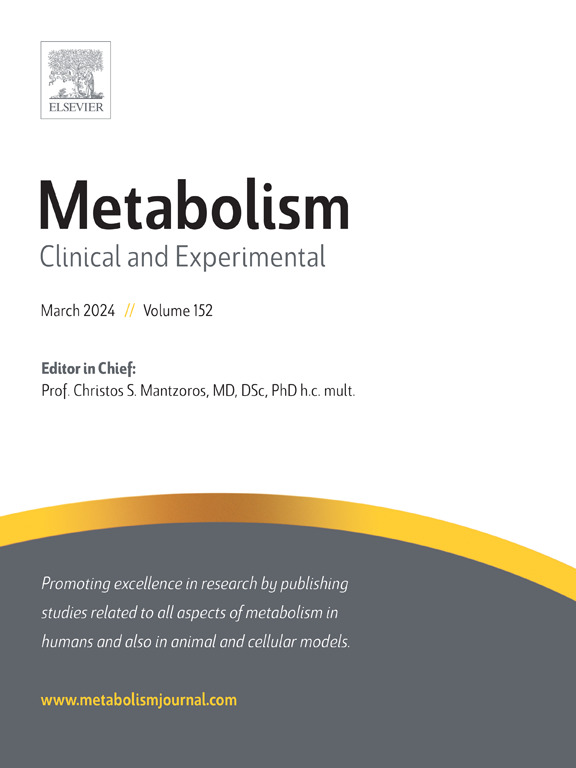血清miR-365b-5p/miR-222-5p作为减肥手术后病态肥胖患者长期体重减轻的潜在诊断生物标志物
IF 10.8
1区 医学
Q1 ENDOCRINOLOGY & METABOLISM
引用次数: 0
摘要
背景:并不是所有的病态肥胖(MO)患者都能在减肥手术后成功减肥。本研究旨在确定血清miRNA谱是否可以预测这一结果。设计:33例MO患者被分为“良好反应者”(GR,超重减重百分比(%EWL) ≥ 50 %)或“无反应者”(NR, %EWL )结果:GR和NR之间发现56个差异表达的mirna。Logistic回归模型显示hsa-miR-365b-5p (GR中上调)和hsa-miR-222-5p (NR中上调)两种mirna与%EWL相关。受体工作特征曲线显示,这些mirna的组合是区分GR和NR的最佳血清mirna谱。实验验证的这些mirna靶基因参与了应激反应、细胞周期、转导以及发育和增殖过程。在hsa-miR-365b-5p模拟物和hsa-miR-222-5p抑制剂联合培养的人类脂肪细胞中,6个参与脂肪形成和脂肪细胞分化的基因(STAT3、ILR7、PARP1、SOD2、FGF2和TMEM18)的体外表达在脂肪形成过程中下调,在脂质形成过程中上调。结论:基线血清hsa-miR-365b-5p和hsa-miR-222-5p能够预测减肥手术后5-8 年的%EWL。这些潜在的预测性生物标志物的组合参与调节与肥胖相关的基因表达水平。然而,这些影响可以根据其他刺激而改变。本文章由计算机程序翻译,如有差异,请以英文原文为准。
Serum miR-365b-5p/miR-222-5p as a potential diagnostic biomarker for long-term weight loss in patients with morbid obesity after bariatric surgery
Background
The successful weight loss following bariatric surgery is not achieved in all patients with morbid obesity (MO). This study aims to determine whether a serum miRNA profile can predict this outcome.
Design
Thirty-three patients with MO were classified in “Good Responders” (GR, percentage of excess weight loss (%EWL) ≥ 50 %) or “Non-Responders” (NR, %EWL < 50 %) according to the %EWL 5–8 year following bariatric surgery. Baseline serum miRNA sequencing was performed to find predictor biomarkers and human adipocyte culture were performed to determine their effect.
Results
Fifty-six differentially expressed miRNAs were found between GR and NR. Logistic regression models showed two miRNAs, hsa-miR-365b-5p (upregulated in GR) and hsa-miR-222-5p (upregulated in NR) associated to %EWL. Receiver operating characteristic curves showed that the combination of these miRNAs was the best serum miRNAs profile that distinguished between GR and NR. The experimentally validated target genes of these miRNAs were involved in processes related to the response to stress, cell cycle, transduction, and development and proliferation processes. The in vitro expression of six genes involved in adipogenesis and adipocyte differentiation (STAT3, ILR7, PARP1, SOD2, FGF2 and TMEM18) was downregulated in lipogenic and upregulated in lipolitic conditions in human adipocytes incubated with the combination of a hsa-miR-365b-5p mimic and a hsa-miR-222-5p inhibitor.
Conclusions
Baseline serum hsa-miR-365b-5p and hsa-miR-222-5p were able to predict %EWL 5–8 years following bariatric surgery. The combination of these potential predictive biomarkers was involved in regulating the expression levels of genes associated with obesity. However, these effects could be modified depending of other stimuli.
求助全文
通过发布文献求助,成功后即可免费获取论文全文。
去求助
来源期刊

Metabolism: clinical and experimental
医学-内分泌学与代谢
CiteScore
18.90
自引率
3.10%
发文量
310
审稿时长
16 days
期刊介绍:
Metabolism upholds research excellence by disseminating high-quality original research, reviews, editorials, and commentaries covering all facets of human metabolism.
Consideration for publication in Metabolism extends to studies in humans, animal, and cellular models, with a particular emphasis on work demonstrating strong translational potential.
The journal addresses a range of topics, including:
- Energy Expenditure and Obesity
- Metabolic Syndrome, Prediabetes, and Diabetes
- Nutrition, Exercise, and the Environment
- Genetics and Genomics, Proteomics, and Metabolomics
- Carbohydrate, Lipid, and Protein Metabolism
- Endocrinology and Hypertension
- Mineral and Bone Metabolism
- Cardiovascular Diseases and Malignancies
- Inflammation in metabolism and immunometabolism
 求助内容:
求助内容: 应助结果提醒方式:
应助结果提醒方式:


